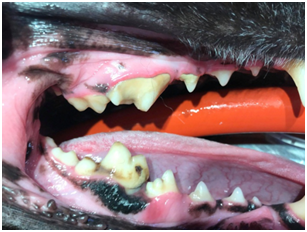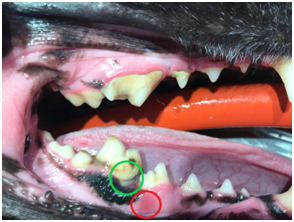Appearances can be deceiving
We brush our teeth every day, at least twice a day. Few of us are able to do the same with our animals. No wonder then, that there comes a time in their life where the need for a teeth scaling is required. Each year, during a vaccination visit or simply during a health examination, a mouth exam is conducted to assess the need for such a procedure. But with doggie squirming in all directions and who does not always appreciate our manipulations, this is not necessarily easy to do. It can then happen that lesions go completely unnoticed, in a mouth at first glance healthy.
This was the case of the patient in the following pictures, who had only a very weak tartar buildup. The owner, wishing to be proactive in maintaining the oral health of her dog, came in to have its mouth evaluated in anticipation of a teeth cleaning. For an inexperienced eye, this mouth could have looked healthy overall. The owner herself had not noticed any change in her dog's mouth, nor noticed a change in behavior or a manifestation of pain.

During the examination, however, the veterinarian's eye was able to detect subtle changes:
- First notice the tiny red dot on the bottom gum (circled in red).
- Then note how the line of the gingiva goes down the dental crown, thus exposing the root (circled in green).

After a thorough examination under anesthesia, we found that there was, at the level of this tooth, a large periodontal pocket. It is a localized detachment of the gum, creating a pocket in which debris accumulate, leading to the formation of bacteria and possibly an abscess. Pressing the gum at this point, pus came out through the little red dot. A path, called a fistula, was formed from the periodontal pocket to allow the evacuation of pus. It was also noted that the teeth on the same side as the lesions had a slightly larger tartar buildup than the other side. We can therefore suspect that this lesion was uncomfortable and that the patient was mainly using the other side of his mouth to chew.
This mouth that seemed rather healthy at first sight was actually hiding a rather painful lesion. To prevent this from damaging the surrounding teeth, we had to remove this tooth. Like what the severity of tartar accumulation is not the only criteria to evaluate to establish the state of health of a jaw.

